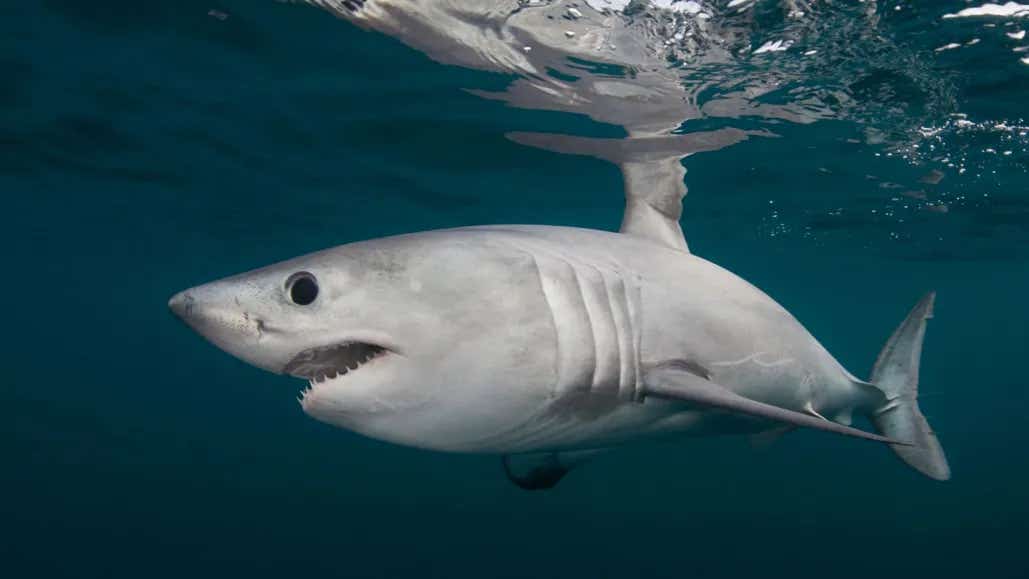Researchers discover the first known case of a shark being eaten by another larger shark
The marine mystery sheds light on an intriguing predator-prey interaction that could have broader implications for marine ecosystems.

Researchers from the US believe a larger shark is responsible for the death of a pregnant porbeagle shark in the open ocean southwest of Bermuda. (CREDIT: CC BY-SA 3.0)
A marine mystery has emerged, and the culprit may be lurking beneath the waves. Researchers from the US believe a larger shark is responsible for the death of a pregnant porbeagle shark in the open ocean southwest of Bermuda. This investigation, detailed in Frontiers in Marine Science, sheds light on an intriguing predator-prey interaction that could have broader implications for marine ecosystems.
Lead author Dr. Brooke Anderson, who was a graduate student at Arizona State University during the study, highlighted the significance of the event, saying, “This is the first documented predation event of a porbeagle shark anywhere in the world.”
The loss of the female porbeagle and her developing offspring could have a profound impact on the species’ population, particularly if such predation is more common than previously thought. "If predation is more widespread than previously thought, there could be major impacts for the porbeagle shark population that is already suffering due to historic overfishing."
Porbeagle sharks inhabit the Atlantic, South Pacific, and Mediterranean seas. They are known for their size and strength, reaching up to 3.7 meters in length and weighing as much as 230 kg. These sharks can live for decades, with some estimates suggesting a lifespan of up to 65 years.
However, their reproductive rate is slow. Females don’t begin reproducing until they are around 13 years old and typically give birth to just four pups every one or two years. Each pup is born live after a gestation period of eight to nine months. This slow reproductive cycle makes it difficult for the population to recover from threats like overfishing, bycatch, and habitat degradation. In fact, porbeagles in the Northwest Atlantic are classified as endangered by the IUCN Red List, while populations in the Northeast Atlantic and Mediterranean are considered critically endangered.
The study into this predation event began with a broader investigation into porbeagle migration. In 2020 and 2022, Anderson and her team tagged several porbeagle sharks near Cape Cod, Massachusetts. Each shark was equipped with two types of satellite tags: a fin-mounted transmitter and a pop-off satellite archival tag (PSAT). The fin-mount tag sends location data whenever the shark’s fin breaks the surface, while the PSAT continuously records depth and temperature. After a set time, the PSAT detaches from the shark, floats to the surface, and transmits its stored data to a satellite.
Related Stories:
One of the sharks tagged during this project was a pregnant female measuring 2.2 meters long. The researchers had high hopes for this particular shark, as data from her movements could reveal key habitats for expectant porbeagle mothers and their newborns. But something unexpected happened.
About 158 days after being released, the female shark’s PSAT began transmitting from the surface near Bermuda. This indicated that the tag had detached early. The transmitted data showed that for five months, this shark had been swimming between depths of 100 and 200 meters at night and between 600 and 800 meters during the day. The water temperatures ranged from 6.4 to 23.5 degrees Celsius. During this time, the fin-mount tag only transmitted once, confirming that the shark spent most of its time underwater.
Then, on March 24, 2021, something changed. Over the next four days, the temperature recorded by the PSAT remained steady at around 22 degrees Celsius, and the shark’s depth fluctuated between 150 and 600 meters. The most plausible explanation? The porbeagle had been hunted and consumed by a larger predator, and the PSAT was later excreted and began transmitting from the surface.
The researchers identified two possible suspects: the great white shark (Carcharodon carcharias) and the shortfin mako shark (Isurus oxyrinchus). Both of these predators are large enough to hunt adult porbeagles and are found in the same waters at the same time of year. However, the team leaned toward the great white as the more likely predator. Shortfin mako sharks typically exhibit rapid oscillating dives between the surface and deeper waters during the day, a behavior that was not detected in the data from the PSAT.
“Two endothermic predator candidates large enough to predate upon mature porbeagles and located within the vicinity and at the time of year of the predation event include the white shark Carcharodon carcharias and shortfin mako Isurus oxyrinchus,” the authors noted in their paper.
Although great white sharks are known for preying on a variety of marine animals, including whales, dolphins, seals, and rays, this predation event was an eye-opener for the team.
Anderson reflected on the discovery, saying, “The predation of one of our pregnant porbeagles was an unexpected discovery. We often think of large sharks as being apex predators. But with technological advancements, we have started to discover that large predator interactions could be even more complex than previously thought.”
The implications of this predation are significant. Porbeagles are already facing numerous threats, and the added pressure of predation by other large sharks could further hinder their ability to recover. “We need to continue studying predator interactions to estimate how often large sharks hunt each other,” Anderson emphasized. “This will help us uncover what cascading impacts these interactions could have on the ecosystem.”
While this event may seem like a singular occurrence, it raises important questions about the dynamics between marine predators. As researchers continue to unravel these complex interactions, they may uncover new insights into the delicate balance of ocean ecosystems and the ripple effects of predator-prey relationships.
Note: Materials provided above by The Brighter Side of News. Content may be edited for style and length.
Like these kind of feel good stories? Get The Brighter Side of News' newsletter.
Rebecca Shavit
Science & Technology Journalist | Innovation Storyteller
Based in Los Angeles, Rebecca Shavit is a dedicated science and technology journalist who writes for The Brighter Side of News, an online publication committed to highlighting positive and transformative stories from around the world. With a passion for uncovering groundbreaking discoveries and innovations, she brings to light the scientific advancements shaping a better future. Her reporting spans a wide range of topics, from cutting-edge medical breakthroughs and artificial intelligence to green technology and space exploration. With a keen ability to translate complex concepts into engaging and accessible stories, she makes science and innovation relatable to a broad audience.



